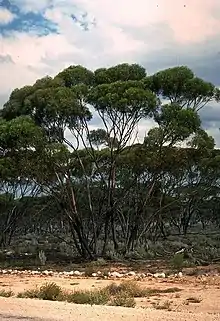Eucalyptus melanoxylon
Eucalyptus melanoxylon, commonly known as black morrell,[2] is a species of small to medium-sized tree that is endemic to Western Australia. It has hard, fissured bark on some or all of its trunk, linear to narrow lance-shaped leaves, flower buds in groups of between seven and fifteen, white flowers and conical to cup-shaped fruit.
| Black morrell | |
|---|---|
 | |
| Scientific classification | |
| Kingdom: | Plantae |
| Clade: | Tracheophytes |
| Clade: | Angiosperms |
| Clade: | Eudicots |
| Clade: | Rosids |
| Order: | Myrtales |
| Family: | Myrtaceae |
| Genus: | Eucalyptus |
| Species: | E. melanoxylon |
| Binomial name | |
| Eucalyptus melanoxylon | |
Description
Eucalyptus melanoxylon is a tree that typically grows to a height of 4–24 m (13–79 ft), sometimes a robust mallee, and forms a lignotuber. It has hard, thick, fissured bark on the trunk and larger branches or sometimes only on the lower half, and white to greyish bark above. Young plants and coppice regrowth have dull greenish leaves that are lance-shaped, 40–75 mm (1.6–3.0 in) long and 12–30 mm (0.47–1.18 in) wide. Adult leaves are the same glossy green on both surfaces, linear to narrow lance-shaped, 72–110 mm (2.8–4.3 in) long and 7–12 mm (0.28–0.47 in) wide on a petiole 7–15 mm (0.28–0.59 in) long. The flower buds are arranged in groups of between seven and fifteen on an unbranched peduncle 8–15 mm (0.31–0.59 in) long, the individual buds on pedicels 3–5 mm (0.12–0.20 in) long. Mature buds are oval, 5–8 mm (0.20–0.31 in) long and 3–5 mm (0.12–0.20 in) wide with a conical to rounded operculum. Flowering occurs between November and March and the flowers are white. The fruit is a woody conical to cup-shaped capsule 4–6 mm (0.16–0.24 in) long and 5–6 mm (0.20–0.24 in) wide with the valves protruding.[2][3][4]
Taxonomy
Eucalyptus melanoxylon was first formally described in 1923 by Joseph Maiden in his book, A Critical Revision of the Genus Eucalyptus from specimens collected near Westonia.[5][6]
Distribution and habitat
Black morrell occurs in southern Western Australia from Westonia, Bullabulling and Lake King in the eastern wheatbelt to Balladonia in the eastern goldfields. It is found in depressions and on flats where it grows in sand-clay-loamy soils.[2][3][4]
Conservation status
This eucalypt is classified as "not threatened" by the Western Australian Government Department of Parks and Wildlife.[2]
See also
References
- "Eucalyptus melanoxylon". Australian Plant Census. Retrieved 3 November 2019.
- "Eucalyptus melanoxylon". FloraBase. Western Australian Government Department of Parks and Wildlife.
- "Eucalyptus melanoxylon". Euclid: Centre for Australian National Biodiversity Research. Retrieved 31 May 2020.
- Chippendale, George M. "Eucalyptus melanoxylon". Australian Biological Resources Study, Department of the Environment and Energy, Canberra. Retrieved 3 November 2019.
- "Eucalyptus melanoxylon". APNI. Retrieved 3 November 2019.
- Maiden, Joseph (1923). A Critical Revision of the Genus Eucalyptus. Sydney: New South Wales Government Printer. pp. 351–352. Retrieved 3 November 2019.